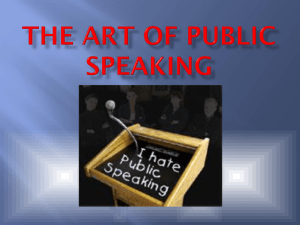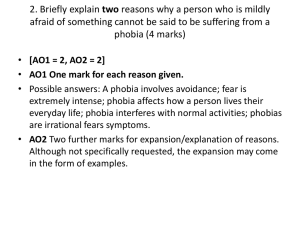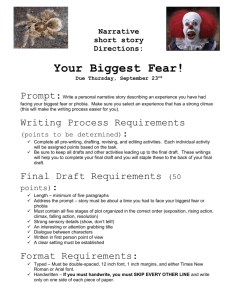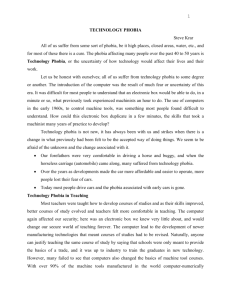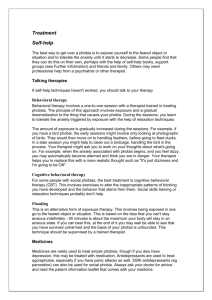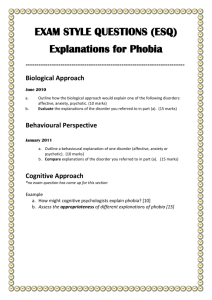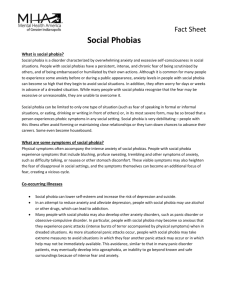Phobia Project ()
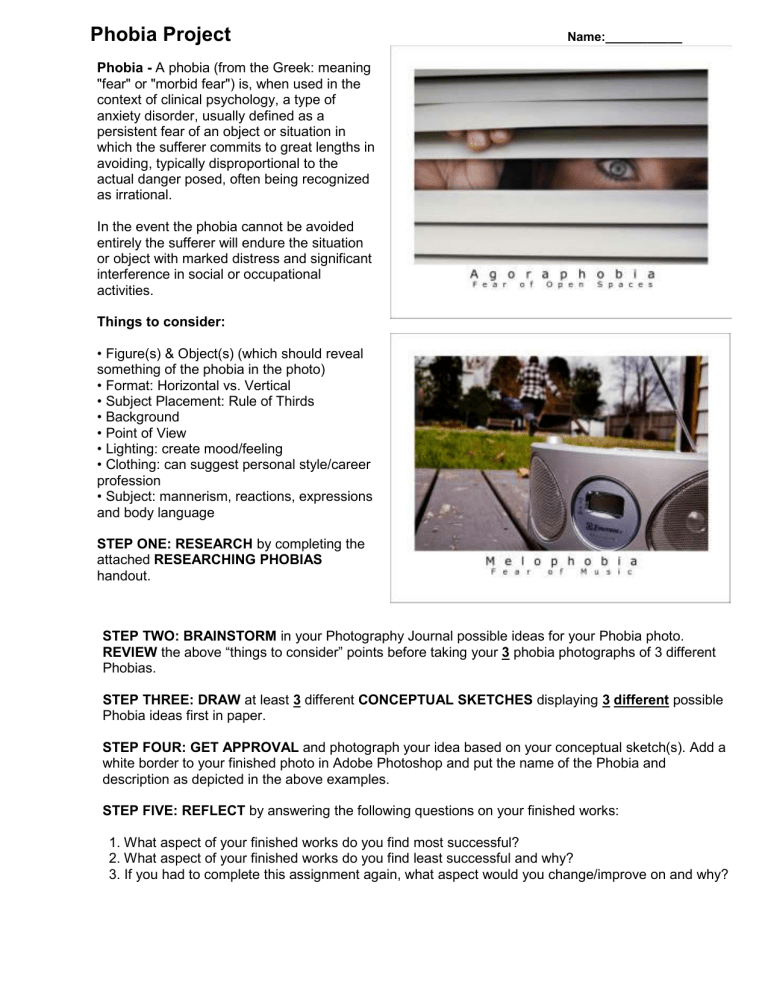
Phobia Project
Name:___________
Phobia - A phobia (from the Greek: meaning
"fear" or "morbid fear") is, when used in the context of clinical psychology, a type of anxiety disorder, usually defined as a persistent fear of an object or situation in which the sufferer commits to great lengths in avoiding, typically disproportional to the actual danger posed, often being recognized as irrational.
In the event the phobia cannot be avoided entirely the sufferer will endure the situation or object with marked distress and significant interference in social or occupational activities.
Things to consider:
• Figure(s) & Object(s) (which should reveal something of the phobia in the photo)
• Format: Horizontal vs. Vertical
• Subject Placement: Rule of Thirds
• Background
• Point of View
• Lighting: create mood/feeling
• Clothing: can suggest personal style/career profession
• Subject: mannerism, reactions, expressions and body language
STEP ONE: RESEARCH by completing the attached RESEARCHING PHOBIAS handout.
STEP TWO: BRAINSTORM in your Photography Journal possible ideas for your Phobia photo.
REVIEW the above “things to consider” points before taking your 3 phobia photographs of 3 different
Phobias.
STEP THREE: DRAW at least 3 different CONCEPTUAL SKETCHES displaying 3 different possible
Phobia ideas first in paper.
STEP FOUR: GET APPROVAL and photograph your idea based on your conceptual sketch(s). Add a white border to your finished photo in Adobe Photoshop and put the name of the Phobia and description as depicted in the above examples.
STEP FIVE: REFLECT by answering the following questions on your finished works:
1. What aspect of your finished works do you find most successful?
2. What aspect of your finished works do you find least successful and why?
3. If you had to complete this assignment again, what aspect would you change/improve on and why?
K/U: RESEARCHING PHOBIAS Name:___________
A) 1. What is a phobia? (1)
2. List and define 5 phobias from The Phobia List: http://phobialist.com/
1. -
2. -
3. -
4. -
5. -
B) Photographic/digital manipulation techniques used in my works and how they support my intended visual messages:
C) REFLECT by answering the following questions on your finished work:
1. What aspect of your finished works do you find most successful?
2. What aspect of your finished works do you find least successful and why?
3. If you had to complete this assignment again, what aspect would you change/improve on and why?
Phobia Project Rubric
Level 0 Level 1
Knowledge/
Understanding
Demonstrates understanding of the elements & principles of design
Work does not meet assignments expectations for this category.
Incomplete.
0
Student demonstrates limited understanding of the elements & principles of design.
0.25
Thinking/
Inquiry
1 Phobia Photo
2 Phobia Photo
3 Phobia Photo
Work does not meet assignments expectations for this category.
Incomplete.
0
Incomplete.
0
Incomplete.
0
Communication
Clarity:
Discusses research
& influences in the research questions
& artistic statement
Explains use of
Manipulation/Transf ormation,
Operational techniques in the artistic statement
Reflective
Questions: Strength,
Weakness & Next
Step
Work does not meet assignments expectations for this category.
Incomplete.
0
Incomplete.
0
Incomplete.
0
Student depicts their Phobia with limited effectiveness.
0.25
Student depicts their Phobia with limited effectiveness.
0.25
Student depicts their Phobia with limited effectiveness.
0.25
Student discusses influences in the research questions & artistic statement with limited clarity.
0.25
Student explains use of techniques in the artistic statement with limited clarity.
0.25
Poor, yes/no answers/limited incomplete.
0.25
Application
Creative Process:
Demonstration of
Skill Development & following procedures including Clean Up
Creative Process:
3 Conceptual
Sketches;
3 Final Digital
Images;
Uses elements & principles of design and Manipulation/
Transformation,
Operational techniques to produce an effective
Phobia photos
Incomplete.
0
Incomplete.
0
Student demonstrates limited effectiveness in demonstrating the creative process and following procedures.
5
Student demonstrates limited use of the elements & principles of design and techniques to produce art works of limited effectiveness.
1
Level 2
Name:_____________
Level 3 Level 4
Student demonstrates some understanding of the elements & principles of design.
0.50
Student depicts their
Phobia with some effectiveness.
0.50
Student depicts their
Phobia with some effectiveness.
0.50
Student depicts their
Phobia with some effectiveness.
0.50
Student demonstrates considerable understanding of the elements & principles of design.
0.75
Student depicts their
Phobia with considerable effectiveness.
0.75
Student depicts their
Phobia with considerable effectiveness.
0.75
Student depicts their
Phobia with considerable effectiveness.
0.75
Student demonstrates a high degree of understanding of the elements & principles of design.
1
Student depicts their Phobia with superior effectiveness.
1
Student depicts their Phobia with superior effectiveness.
1
Student depicts their Phobia with superior effectiveness.
1
/1
/1
/1
/1
Student discusses influences in the research questions
& artistic statement with some clarity.
0.50
Student explains use of techniques in the artistic statement with some clarity.
0.50
Student discusses influences in the research questions
& artistic statement with considerable clarity.
0.75
Student explains use of techniques in the artistic statement with considerable clarity.
0.75
Student discusses influences in the research questions & artistic statement /1 with a high degree of clarity.
1
Student explains use of techniques in the artistic statement with a high degree of
/1
Somewhat coherent and somewhat complete.
0.50
Clear and substantial answers.
0.75 clarity.
1
Superior and insightful
/1 answers.
Student demonstrates some effectiveness in demonstrating the creative process and following procedures.
5-6
Student demonstrates some use of the elements
& principles of design and techniques to produce art works of some effectiveness.
2-3
Student demonstrates considerable effectiveness in demonstrating the creative process and following procedures.
7-8
Student demonstrates considerable use of the elements & principles of design and techniques to produce art work of considerable effectiveness.
3-4
1
Student demonstrates superior effectiveness in demonstrating the creative process and following procedures.
8- 10
Student demonstrates a high degree of using the elements & principles of design and techniques to produce highly effective art works.
5
/10
/5
/ 22
A1. The Creative Process: apply the creative process to create a variety of artworks, individually and/or collaboratively;
A1.1 use various strategies, individually and/or collaboratively, with increasing skill to generate, explore, and elaborate on original ideas and to develop, reflect on, and revise detailed plans for the creation of art works that address a variety of creative challenges (e.g., extend their skills in using brainstorming, concept webs, mind maps, and/or groups discussions to formulate original and innovative ideas for an art work on a social or personal theme; use critical research skills to explore and elaborate on ideas; demonstrate fluency in formulating clear and detailed plans; demonstrate flexibility in revising their plans on the basis of reflection)
A1.2 apply, with increasing fluency and flexibility, the appropriate stages of the creative process to produce two- and three-dimensional art works using a variety of traditional and contemporary media (e.g., extend their skills in working with a range of media; demonstrate flexibility in revising plans in response to problems encountered during other stages of the creative process; reflect on the effectiveness of preliminary versions of their work, and revise the work on the basis of reflection and self-assessment)
A1.3 document their use of each stage of the creative process, and provide evidence of critical inquiry, in a portfolio that includes a range of art works created for a variety of purposes (e.g., ensure that their portfolio includes the following: evidence of critical inquiry associated with idea generation and elaboration; evidence of research on how different artists approach specific themes and/or use particular techniques that can be adapted in their own work; preliminary and final works to show evidence of thoughtful revision), and review and reflect on the contents of their portfolio to determine how effectively they have used the creative process
A2. The Elements and Principles of Design: apply the elements and principles of design to create art works for the purpose of self-expression and to communicate ideas, information, and/or messages;
A2.1 apply the elements and principles of design with increasing skill and creativity to produce two- and three-dimensional art works that express personal feelings and communicate specific emotions (e.g., extend their skills in combining various elements and principles to convey a sense of fear, happiness, hopefulness, despair)
A2.2 apply the elements and principles of design as well as a wide range of art-making conventions with increasing skill and creativity to produce art works that comment and/or communicate a clear point of view on a variety of issues (e.g., extend their skills by manipulating elements and principles and using conventions in creative ways to produce an art work that conveys the point of view of a teenager living on the street or that comments on a current event or social issue)
A3. Production and Presentation: produce art works, using a variety of media/materials and traditional and emerging technologies, tools, and techniques, and demonstrate an understanding of a variety of ways of presenting their works and the works of others.
A3.1 use with increasing skill a wide variety of media, including alternative media, and current technologies to create two- and three-dimensional art works for a variety of purposes (e.g., extend their skills in the manipulation of a variety of media and technologies to create a sculpture for an outdoor space, a mixed-media work for display on the Internet, an installation evoking their cultural heritage)
A3.2 use with increasing skill a wide variety of traditional and current materials, technologies, techniques, and tools to create original art works for a variety of purposes and audiences
B1. The Critical Analysis Process: demonstrate an understanding of the critical analysis process by examining, interpreting, evaluating, and reflecting on various art works;
B1.1 demonstrate the ability to support their initial responses to a variety of art works with informed understanding of the works’ artistic form and function (e.g., describe their initial response to an art work, and explain in detail how specific aspects of the work’s content, formal qualities, and media inform that response)
B1.2 deconstruct with increasing skill and insight the visual content and the use of elements and principles of design in their own art work and the work of others (e.g., extend their skills in identifying individual elements and principles and aspects of the visual content in an art work, interpreting their function, and analysing their effect; compare and contrast the use of shape, form, line, texture, space, and balance in Frank Lloyd Wright’s Falling Water and Moshe Safdie’s Habitat)
B1.4 describe in detail and reflect on with increasing insight the qualities of their art works and the works of others, and evaluate the effectiveness of these works using a wide variety of criteria (e.g., provide an informed explanation of why a work of art is, or is not, successful with respect to its ability to communicate a message or emotion, its technical and aesthetic conventions, its form and stylistic qualities, its originality)
B2. Art, Society, and Values: demonstrate an understanding of how art works reflect the societies in which they were created, and how they can affect both social and personal values;
C1. Terminology: demonstrate an understanding of, and use correct terminology when referring to, elements, principles, and other components related to visual arts;
C1.1 extend their understanding of the elements and principles of design, and use terminology related to these elements and principles
correctly and appropriately when creating or analysing a variety of art works (e.g., when analysing how artists’ manipulation of space,
movement, form, and proportion affects meaning in an installation or an environmental work)
C1.2 explain in detail terminology related to a wide variety of techniques, materials, and tools (e.g., techniques and materials associated with installation art; additive and subtractive techniques, digital manipulation, impasto, optical colour mixing, pointillism), and use this terminology correctly and appropriately when creating, analysing, and/or presenting art works
C1.3 explain in detail the stages of the creative process and the critical analysis process, and explain, using appropriate terminology, how these processes contribute to the successful creation and analysis of art works
C2. Conventions and Techniques: demonstrate an understanding of conventions and techniques used in the creation of visual art works;
C2.1 extend their understanding of a wide variety of techniques that artists use to achieve a range of specific effects (e.g., techniques used to create a range of textures in an art work, to develop the connection and relationship between forms in a composition, to draw attention to specific parts of a work)
C2.2 extend their understanding of the variety of conventions used in visual art (e.g., allegory, appropriation, juxtaposition, synectics; conventions associated with formalism, objective and non-objective abstraction, propaganda, realism, social commentary), and explain in detail how they are used in a variety of art works
C3. Responsible Practices: demonstrate an understanding of responsible practices in visual arts.
C3.2 demonstrate appropriate health and safety procedures and conscientious practices in the selection and use of various materials, techniques, tools, and technologies when producing or presenting art works (e.g., demonstrate safe practices when creating installations, assemblages, earthworks, constructions, multimedia projects; demonstrate appropriate protocols, deportment, and respect for others when working in a studio or visiting a presentation space)
